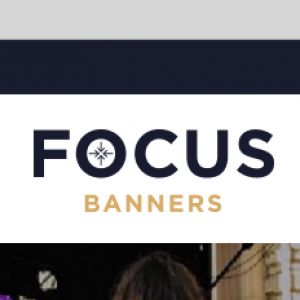Fabric Banners Are The Future Of BrandingPosted by Focus Banners on January 29th, 2020 Print technology is constantly evolving. In print materials, this means we are starting to come full circle. Not so long ago we used to print everything on paper. Billboards and posters were paper products - had there been recycling they would have had a new life. The explosion in plastics was a boon to the signage industry. PVC replaced paper billboards. The life expectancy of a banner became much longer. Synthetic paper (aka plastic) replaced paper posters. Advertising looked better but we create an enormous plastic waste problem. Companies have become more conscious of the footprint they create. How they make money and what they preach can often be dissonant but we are at very beginning of a long process. Environmental awareness has been creeping up on even the most sceptical of companies. Buyers are choosing to buy from companies that show environmental and ethical responsibility.
In the signage world this means a move toward products that have a secondary life rather. Waste stations around the world are full of old advertising which is either burnt or buried. Signs are often single use plastics, particularly in events where they are often used for a few hours. Enter fabric banners. Advances in printers and materials deliver incredible graphic reproduction. The wide variety of banner fabric substrates has created new print products. Here are some examples of products which didn't exist until recently: 1. Media Walls. These portable and lightweight mediums can create large branded spaces and backdrops. Printed polyester fabric is stretched taut over an aluminium frame. 2. SEG Frames. Silicon edge graphics have had a meteoric rise in shopping centres around the world. A special shaped silicon rope is sewn onto the outside edge of a fabric banner. The edging is then forced into a slot in an aluminium frame. The result is a beautiful borderless ad. The other beauty is that SEG graphics do not need expensive installers. This saves retailers a lot of money and headaches. 3. Teardrop flags. Here in Australia it is hard to imagine they didn't exist a decade ago. They are so prevalent in every urban area that we ignore them. Except that they do what all good branding should do and they create subliminal markers. These are just a few of the very many products made using polyester materials. Polyester as a printable material is extremely versatile. The downside to polyester is that it does not hold inks as well as other methods. In fabric printing, the inks are sublimated into the fabric using heat. Polyester fabrics do fade over time, especially when exposed to harsh UV. The upside, apart from the new products that have come about because of fabric printing, is that it is NOW recyclable. Polyester banners can be recycled like other products made from PET. Focus Banners are at the forefront of the movement. Our plan is to drive change and end waste in signage. Like it? Share it!More by this author |



